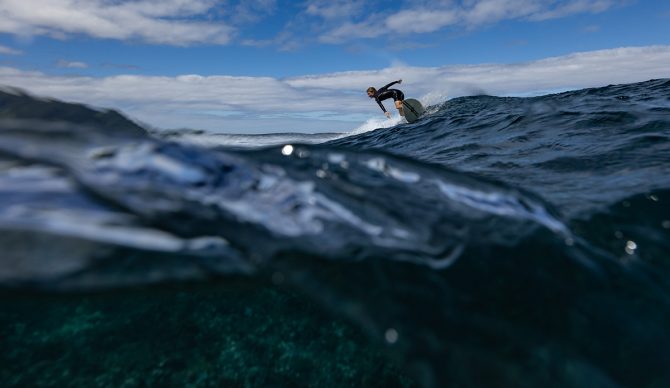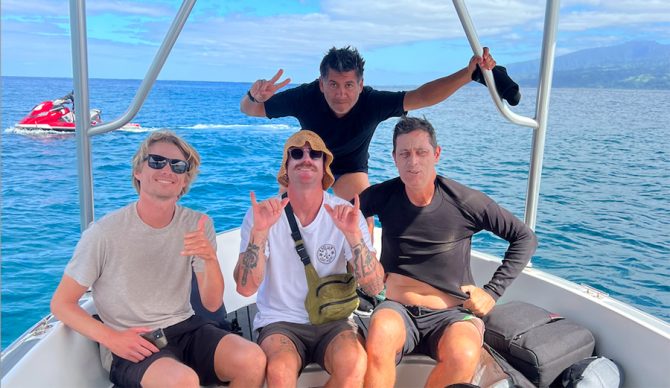
The author, basking in the perks. Photo: Carlos Barria
Before leaving to cover the 2024 Olympics in Tahiti, I penned a story on my blog posing a question of utmost importance: Will I get to surf? I’ve worked a number of surf events over the years (formerly on the organizer’s side) to know that surfing is not often in the cards. In fact, I have a formula that computes how often I’ll get to surf on these trips. I ask myself three questions: Can I walk to the wave? If not, do I have some type of transportation? And is sunrise early enough to allow for a pre-comp session?
In Tahiti, the waves were mainly outer reefs, I didn’t have a car, and first light was around 6 a.m. When I plugged all this into the formula, the answer was, “probably not going to surf much.” However, the fact that the Olympics only needed four to five days to run was one factor that worked in my favor. Unfazed by the odds, I brought two boards.
When I worked at the 2020 Olympics in Japan, I essentially didn’t surf at all during the event. But the day after the Olympics, when all the competitors had jetted home, there was an epic day of offshore tubes for the staff. I got one barrel that I still remember. So I learned it’s better to eat the board fees and not surf than to experience the crippling FOMO of missing an epic day of waves if the opportunity arose.
The first three days of the 2024 Olympic window were all work, but when the swell got huge and messy and the wind turned onshore, the event was called off. At the same time, Teahupo’o’s little novelty river mouth turned on. It was my first chance to get in the water.
The reef pass at Teahupo’o is about 800 feet wide – just big enough to allow the energy of a huge swell to pass through and grace the cobblestone river mouth in town. By the time the double overhead waves at Teahupo’o filter through the pass, they’re waist- to chest-high, creating a fun right that even provides little tube sections before running into the beach.
With the competition off and a nice right breaking in town, as you might imagine, it was extremely crowded from dawn to dusk. Faces in the lineup varied from eight-year-old Teahupo’o groms to world champions to event staff to journalists like myself. I spotted Carissa Moore, Alan Cleland, Molly Picklum, Caity Simmers, and Caroline Marks tearing the tiny walls to shreds.
I paddled out at dusk on Tuesday, then dawn and dusk on Wednesday. The locals were very welcoming, but when the sets came it was clear that they were not for foreigners. One pre-teen on a blue soft-top easily matched the wave total of the rest of the 25-person lineup combined by himself. I took the scraps and looked for waves that swung deep or wide. It was good to get wet, but the novelty was wearing off with the Olympic crowds. I longed for something more. My eyes turned to the outer reefs.
On Thursday the competition resumed and I returned to my coverage routine, talking to athletes in the mixed zone and smacking a keyboard in the media center. After nearly a week working in Tahiti, a camaraderie formed among the journalists at my table. Even though technically we compete for readers, clicks and engagement, we bonded over the common line of work that we’d chosen.
Across from me at the table sat Lincoln Feast, a Kiwi journalist with Reuters. To my left sat Dashel Pierson, associate editor of SURFER (and former staffer at The Inertia). Diagonal to me was Pablo Zanocchi, the founder of the Spanish language site Duke Surf. We shared stories about writing assignments and surf trips around the world. We used our combined decades of surf knowledge to factcheck each other and bounce ideas around. (Pablo is a surf encyclopedia.) And Dashel would test my reaction to debatably inappropriate metaphors he inserted into his stories that included terms like “muffin tops” and “edging” (Google it).
We’d also joke about who would win the journalist heat. (Stab’s Michael Ciaramella was the obvious answer and thus excluded from these hypothetical debates.) But when the fourth day of competition wrapped and Friday was called a lay day in advance, we started to think we were due to make that journalist heat a reality.
A day away from the Olympic final (assuming it ran on Saturday), we journalists schemed a way out to the reefs. Teahupo’o was still off-limits, but there are loads of other reef passes throughout this stretch of the Tahitian coast. Pablo arranged a boat to take us to a left called Big Pass and Lincoln swung by in his Reuters-sponsored car to pick up Dashel and me. We strapped our boards to the roof of the tiny French hatchback and headed to the village of Vairao to get some waves.

The heat in question. The only one that really mattered. Photo: Courtesy EQ
A boat picked us up proudly flying the flag of the People’s Republic of China. It’d been contracted by Siqi Yang – China’s 15-year-old surf star – and her support personnel during the Olympics. I learned by chatting with the boat driver that he charged roughly USD $900 per day for three days to be the official Chinese boat. Did someone say the Olympic money wasn’t filtering down to the locals? On the way out to the reef we passed by the famous cruise ship that served as an athletes’ village in Tahiti. Most of the athletes arranged their own accommodation, but some teams, like Germany, Portugal, Japan, New Zealand, El Salvador, and Peru, went with the floating hotel option. And on a hill further west, hidden among the greenery of Tahiti’s mountain peaks, I could spot the mansion on a hill where I’d attended a rager a few nights earlier that was packed with event staff, media, locals, and eliminated Olympians dancing to Reggaeton. (Rumor has it the parties are still going.)
The wave itself was nothing special for Tahiti. But for those of us who hadn’t been surfing tropical coral reef passes for some time, it was amazing. Waist-high lefts with the occasional chest-high set wrapped into the pass with water so clear it was hard to distinguish where to hit the lip. Pablo arrived in the second boat shuttle and hooted as I did a mediocre, backside snap typical of a washed-up, 30-something surfer like myself.
For hours, Lincoln, Dashel, Pablo, an event photographer, an ISA executive, and I traded off waves. There was no hassling; just a simple rotation. Our joints, creaky from a week spent working at desks, began to loosen under the first completely sunny sky in Tahiti since we’d arrived. Carlos Barria, a Reuters photographer (with some incredible war-zone stories), swam and experimented with underwater shots (most of which you won’t see here because they all belong to Reuters).
As far as who won the heat? Dashel managed a shampoo head dip. Pablo was throwing buckets on his backhand carves. Lincoln was having the most fun. I probably finished last with my conservative turns over the shallow inside reef. I didn’t deem the coral worth falling on in mediocre waves.
We returned to the mainland with the euphoric feeling that comes after just spending a day in the sun surfing crowd-less waves. Then it was back to work. Lincoln jetted off to meet Shane Dorian for an interview while I headed home to cover more important stories, like a bunch of journalists surfing a two-foot left in Tahiti.
I’m glad that I kept my expectations low before coming to Tahiti because four sessions have already blown my mind. That reef pass session alone made bringing my boards worth it. This surf journalism gig isn’t the best way to save for a down payment on a house, but, hey, I was in Tahiti. Life wasn’t too bad. Not too bad at all.

